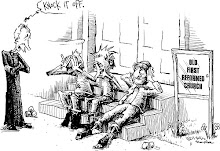
This is the famous Icon by Anton Rublev. It's called The Divine Hospitality, and it's based on the story of the three visitors to Abraham in Genesis 18. Christians have always seen in this Torah story an intimation of the Holy Trinity.
I love this picture of God (I know we're not supposed to picture God). But it's healing for us if imagining God this way breaks the hold that more common images have on our imaginations (like Michelangelo's).
Here God is androgynous, both masculine nor feminine, or maybe neither. (This is Orthodoxy!) Here each person is identical in face, essence, and substance, but discrete in position, office, and attributes.
The Father is on the left, the source and the object of adoration.
The Son is in the middle, wearing a robe of brown and blue for earth and sky --- the Incarnation. He is celebrating Communion.
The Spirit is on the right, wearing a robe of sky and air. The Spirit proceeds from the Father and looks back to the Father by way of the Son.
And we, the world, are represented by that little rectangle on the fall of the tablecloth, which makes us included in the circle of their fellowship.
The icon is constructed with circles and triangles, to represent not only threeness but unity and eternity. They love each other, they are a community.
There is room inside God. God is not a compact substance. There is dynamic and movement inside God. Sorry, Aristotle, but God is not the unmoved mover. God has movement deep inside God's self. And yet it's a movement that's always at rest.
Love is built into God. The three persons love each other. When we say God is love, it is not self-love, but other-love, which is a deeper love than self-love. Other-love wants the other always to be other and stay that way, but in fellowship. There is community in this unity.
The love that God has for us and for the world is an expansion of the love that is dynamically active deep inside God.
And yet each person is of a single essence with the other persons. There are not three Gods, but one God fully in each person.
The reading from John's Gospel for this Pentecost Sunday sets this out this mystery. And next week Sunday celebrates this mystery, the Sunday of the Holy Trinity.
The Trinity cannot be fully understood, nor can it be completely comprehended, but sufficiently so to be loved and worshiped. And aren't love and worship the goal of our human relationship with God?

No comments:
Post a Comment